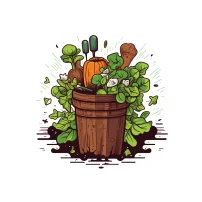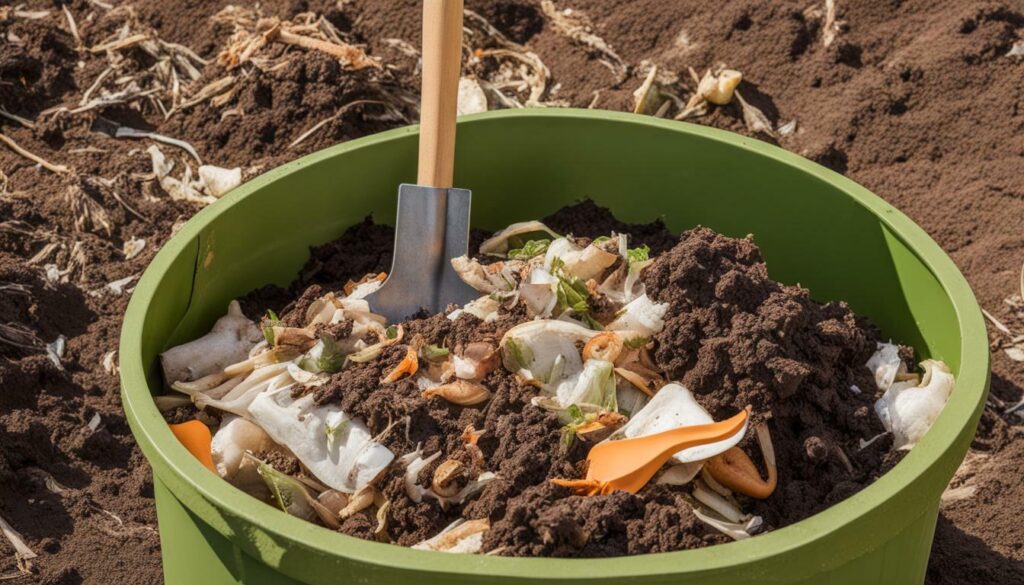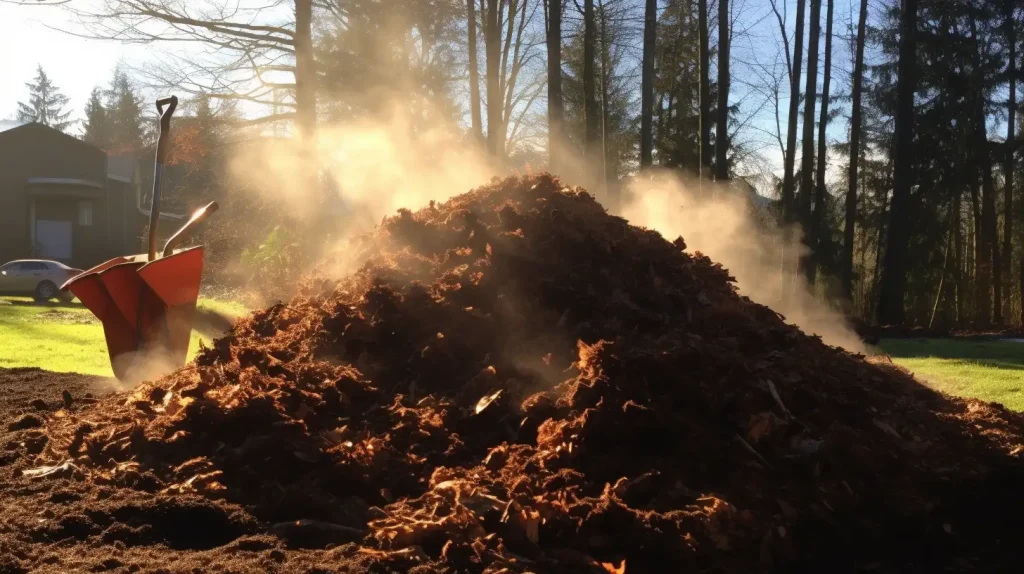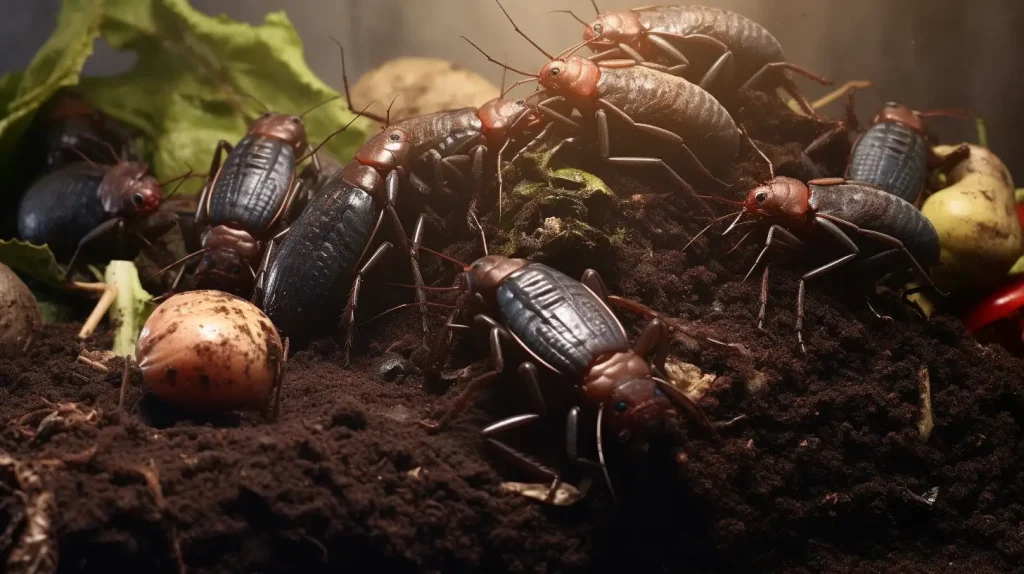Composting is a simple and sustainable way to reduce waste and nourish soil in gardens and farms. However, like any other activity, it comes with its set of challenges. In this article, we will discuss the common challenges faced by composters and provide solutions to overcome them.
Key Takeaways:
- Composting can present difficulties and obstacles that can hinder the process of producing quality compost.
- A lack of knowledge and education about composting, difficulty in achieving a proper balance of ingredients, managing moisture levels, dealing with unwanted pests and rodents, odor control, limited space for composting, and the time and patience required are some of the typical issues in composting.
- Understanding and addressing these challenges are essential for successful composting and a sustainable lifestyle.
Lack of Proper Knowledge and Education
Composting can seem like a daunting task, especially for beginners who lack proper knowledge and education. Without a clear understanding of the composting process, it’s easy to make mistakes that can hinder or even halt progress.
One common problem is adding too much of one type of material, such as too much green or brown material, which can throw off the carbon-to-nitrogen ratio and lead to a slow or ineffective composting process. Another issue is failing to properly aerate the compost pile, which can cause unpleasant smells and attract pests.
To overcome these challenges, it’s important to learn the basics of composting and understand the role of each element. Green materials such as fruit and vegetable scraps provide nitrogen, while brown materials such as dried leaves and wood chips provide carbon. Properly balancing these materials is key to a successful composting process.
Additionally, it’s important to properly maintain the compost pile by turning it regularly to promote airflow and prevent the buildup of moisture. This will also prevent odors and pests from taking over.
Education and knowledge can come from a variety of sources, including online resources, books, and even local classes or workshops. By taking the time to learn about composting, beginners can overcome the common challenges and achieve a thriving compost pile.
Difficulty in Achieving Proper Balance
One of the most common challenges in composting is achieving the proper balance of ingredients. Composting requires a mix of carbon-rich “browns” and nitrogen-rich “greens” for optimal results, but achieving the right balance can be tricky.
Carbon-rich materials include dry leaves, straw, sawdust, and paper, while nitrogen-rich materials include food scraps, grass clippings, and manure. When properly balanced, compost piles will heat up and decompose quickly.
However, achieving balance can be difficult, particularly for beginners. Inexperienced composters may be tempted to add too many greens, resulting in a smelly, slimy pile that doesn’t decompose effectively. Alternatively, adding too many browns can result in a dry, slow-to-decompose pile.
To achieve balance, always aim for a roughly equal mix of browns and greens. If your pile is too dry, add more greens or water. If it’s too wet, add more browns. It’s also helpful to chop or shred materials into small pieces, which will speed up the decomposition process and help ensure a well-balanced mix.
Managing Moisture Levels
One of the common challenges in composting is managing moisture levels. Compost piles require the right amount of moisture to support the decomposition process. Too much moisture can lead to a lack of oxygen, slowing down decomposition and causing a foul odor. On the other hand, insufficient moisture can hinder microbial activity and slow down the breakdown of materials. Here are some tips to manage moisture levels:
- Monitor moisture levels regularly: Check the moisture level of your compost pile using a moisture meter or by squeezing a handful of compost. If it feels too wet and water drips out, it’s too moist. If it feels dry and crumbly, it’s too dry.
- Add dry materials: If your compost pile is too wet, add dry materials such as dead leaves, straw, or shredded newspaper. Mix these materials thoroughly into the compost pile to distribute the moisture evenly.
- Water the compost pile: If your compost pile is too dry, use a watering can or hose to add water. Add water gradually, mixing it into the compost pile until it feels moist but not waterlogged.
- Use a cover: Covering your compost pile with a tarp or lid can help regulate moisture levels. The cover will protect the pile from excess rain and prevent it from drying out too quickly in the sun.
Managing moisture levels is critical to successful composting. Keeping your compost pile at the right moisture level will help ensure that it decomposes correctly and produces high-quality compost.
Dealing with Unwanted Pests and Rodents
One of the most common challenges in composting is dealing with unwanted pests and rodents. These creatures are attracted to the food and shelter found in your compost pile, making it their ideal habitat. However, their presence can pose a threat to both the composting process and your health, as some pests can carry diseases and bacteria.
Some of the most common pests found in compost piles include rats, mice, raccoons, and flies. These pests can cause damage to your compost pile by digging through it, disrupting the layers, and eating the food scraps. They can also create foul odors and attract other pests, making it difficult to manage your compost.
The key to preventing pests and rodents from infesting your compost pile is to eliminate their access to it. This can be done by ensuring that the compost bin or pile is properly secured with a tight-fitting lid and that there are no openings that pests can use to enter. It is also important to avoid adding meat, dairy, and oily foods to your compost, as these can attract pests.
If your compost pile has already been infested with pests, there are several strategies you can use to address the problem. One option is to use natural pest repellents such as garlic, peppermint, or eucalyptus oil, which can be sprayed directly on the compost pile to deter pests. Another option is to place a wire mesh or hardware cloth around the compost bin or pile, which can prevent pests from gaining access.
Finally, it is important to regularly turn and mix your compost pile, as this can discourage pests from making it their home. Turning the pile also helps speed up the composting process, making it less attractive to pests. By taking these steps to prevent and address pests and rodents in your compost pile, you can ensure that your composting journey is a success.
Odor Control
One of the most common challenges in composting is managing unpleasant odors that arise during the process. These odors are caused by the decomposition of organic matter and can be intensified by improper composting practices.
To control odor, it’s important to maintain proper moisture levels and ensure that the compost pile is well-aerated. A lack of oxygen can cause anaerobic decomposition, which produces foul odors. Turning the pile regularly can help replenish oxygen levels and prevent odors.
In addition, avoid adding dairy, meat, or oily foods to the compost pile, as they can produce strong odors and attract pests. Instead, focus on adding vegetable and fruit scraps, leaves, and yard waste.
For those concerned about odor in small spaces, consider using a compost bin with a tight-sealing lid to control odors. Alternatively, consider vermicomposting, which uses worms to decompose organic matter and produces little to no odor.
Limited Space for Composting
One of the most common challenges in composting is the limited space available for those who live in urban environments or small residences. However, limited space does not have to be a barrier to composting.
There are several alternative composting methods suitable for small spaces, such as balcony composting, worm composting, and bokashi composting. These methods can be adapted to suit individual needs and preferences, and can even be combined for maximum efficiency.
Balcony composting involves using a container that fits on a balcony or porch. It can be as simple as a small bin or as complex as a multi-tiered system. Worm composting, also known as vermicomposting, involves using worms to break down food scraps and other organic matter. This method can be done indoors or outdoors and requires only a small amount of space. Bokashi composting involves fermenting organic matter using a special mix of microorganisms, which can be done in a container that fits under a sink or in a closet.
When composting in limited space, it is important to remember to balance the compost properly and to avoid overloading the container. This can lead to unpleasant odors and slow decomposition. It is also important to avoid composting certain materials that can attract pests, such as meat, dairy, and oils.
By using alternative composting methods and adapting them to suit their needs, even those with limited space can overcome the challenge of composting.
Difficulty in Achieving Proper Balance
Composting requires a balanced mixture of carbon-rich and nitrogen-rich materials. However, achieving the right balance can be a challenge for many composters. Adding too much of one material can throw off the balance and slow down the decomposition process.
To overcome this challenge, it’s important to understand the carbon to nitrogen ratio (C:N). The ideal C:N ratio for composting is between 20-30:1. Carbon-rich materials include dry leaves, straw, and wood chips, while nitrogen-rich materials include green leaves, kitchen scraps, and grass clippings.
If your compost pile is too carbon-rich, it will decompose slowly. To solve this, add more nitrogen-rich materials such as vegetable scraps or grass clippings. Conversely, if your compost pile is too nitrogen-rich, it will produce a strong odor. To solve this, add more carbon-rich materials.
Patience is key when it comes to achieving a balanced compost pile. It may take up to several weeks for the pile to stabilize and reach the ideal balance for optimal decomposition.
Remember, a balanced compost pile will produce nutrient-rich compost and ensure a successful composting process.
Conclusion
In conclusion, composting may seem like a daunting task, but it can be a rewarding experience once the common challenges are overcome. Lack of proper knowledge and education, difficulty in achieving proper balance, managing moisture levels, dealing with unwanted pests and rodents, odor control, limited space for composting, and time and patience required are some of the common challenges faced by composters.
It is important to remember that despite these challenges, successful composting is achievable with the right information, tools, and techniques. By understanding and addressing these obstacles, composters can create a healthy and nutrient-rich soil amendment that can benefit their gardens and the environment for years to come.
Therefore, it is essential to equip oneself with the necessary knowledge and tools needed to overcome these composting challenges. Composting not only reduces waste but also contributes to healthier living and a cleaner environment. The journey to successful composting can be challenging, but with patience, perseverance, and creativity, anyone can produce a high-quality compost.



